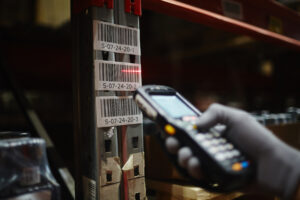If you are like most savvy business people, you are continually on the lookout for new and better technologies to make your operation more efficient and profitable. Among these technologies are barcodes, which can be a great business resource. But, how do barcodes actually work?
In order to maximize the benefits of barcodes, it is important that you understand the proper ways to implement them in your enterprise. So if you’re wondering how barcodes work, then this article will serve as an introduction to creating and printing barcodes. Let’s dive in!
What Are Barcodes?
Barcodes translate the complex features of a product into a simple language that machines can understand. Essentially, these linear or two-dimensional patterns of parallel lines and spaces encode crucial information about an item, such as its identification number, price, or other distinguishing features.
Serving as digital fingerprints, barcodes streamline the checkout process, manage inventory effortlessly, and provide a universal system for tracking goods across the supply chain. From the beep at the checkout counter to the seamless logistics in warehouses, barcodes quietly facilitate the smooth flow of products in our bustling world of retail and beyond.
There are many different types of barcodes and each has a unique purpose for the industry in which it is used. However, every barcode falls under one of two categories: 1D (linear) barcodes and 2D (matrix) barcodes.
1D (Linear) Barcodes

1D barcodes, also known as linear barcodes, are the traditional black-and-white striped patterns found on product labels and packaging. Utilizing a series of parallel lines and spaces of varying widths, they encode alphanumeric information in a linear format.
Widely used for inventory and retail purposes, 1D barcodes streamline transactions, enhance accuracy in product identification, and serve as an efficient tool for tracking items from manufacturing to point of sale.
Types of 1D Barcodes:
- UPC code – retail
- EAN code – retail
- Code 39 – automotive & defense
- Code 128 – supply chain
- ITF – packaging
- Code 93 – retail, manufacturing, & logistics
- Codabar – logistics, healthcare, & education
- GS1 DataBar – retail & healthcare
- MSI Plessey – retail
2D (Matrix) Barcodes

2D barcodes, distinguished by their square or rectangular matrix of black squares arranged on a white background, represent a technological leap beyond their 1D counterparts. Capable of storing significantly more data, including text, numbers, and even small images, 2D barcodes are versatile and space-efficient.
Frequently seen in applications like mobile payments, boarding passes, and product packaging, they offer enhanced functionality and enable quick access to detailed information.
Their ability to hold diverse data makes 2D barcodes invaluable for applications ranging from logistics and healthcare to marketing, providing a compact and powerful means of information storage and retrieval.
Types of 2D Barcodes:
- QR Code – retail, entertainment, & advertising
- Data Matrix Code – electronics, retail, & government
- PDF417 – logistics & government
- Aztec – transportation
How Do Barcodes Work?
When scanned, a barcode reader emits light onto the code, and the contrasting patterns reflect the light back to a photosensitive element in the scanner. The scanner then translates the reflected light into an electrical signal, essentially reading the pattern of bars and spaces. This signal is then decoded into the alphanumeric information embedded in the barcode, whether it be a product code, identification number, or other relevant data.
The beauty of how barcodes work lies in their universality; their standardized format allows them to be read by various scanners, seamlessly integrating them into a vast array of industries for purposes ranging from inventory management to expediting the checkout process at your local store.
Before you can create the graphic part of your barcodes, you must first understand the codes behind them, or literally the coding behind the codes. Also called SKUs, product codes, or item numbers, these are what your final barcodes will stand for. They could also be thought of as the naming convention behind your barcodes. This is the information that barcodes can help you to keep track of.
Creating Your Barcode

Now that you know how barcodes work, let’s discuss how to create the actual barcode. Creating barcodes is a strategic process that goes beyond the visual appeal of those black-and-white patterns. It involves choosing the right barcode type that aligns with your needs, deciding on the essential information to encode, and formulating a clear and intuitive formula for your organization.
Whether generating a single barcode or mass-producing, precision is crucial—individual barcode generators work for smaller needs, while seasoned professionals ensure error-free production for larger volumes. The key lies not just in the graphic design but in crafting a barcode that becomes the invisible thread tying your products, inventory, and business efficiency together seamlessly.
Here are 5 key steps to building the perfect barcodes for your specific applications.
1. Choose the Suitable Type of Barcode
First, what kind of barcode do you want on your product? There are different types of barcodes, each able to accept different types of characters. these different types of barcodes can alter or validate your naming convention. You should decide what kind of barcode is best suited to your use.
2. Decide What Information to Include
Next, you should determine what information is most important to tell your products apart. This might include such factors as the shape, size, color, material, type/category/department, warranty, vendor/manufacturer, quantity, etc. It is important to remember at this point that there is very little that can’t be coded in a barcode, but you must make sure that the information that you want to include is what will best identify the product.
It is also important that you consider the future of your product line at this point. Don’t settle on a barcode that you will quickly outgrow. For example, if you decide that you have a given number of colors of your product, your barcode will quickly become obsolete when you expand to include more colors.
3. Create a Formula
Now, create a formula that is easy to understand by anyone in your organization. It should follow a standard format, such as size, shape, and color. this way it is easy to read the meaning of the code and tell your products apart. Further, to keep the same format, you will be allowing your offerings to grow without interfering with the convention.
It is important to remember to use letters and numbers that are easy to read and are not easy to misread. Consider the use of capital Is and L, for example. When they are used close together, they can be easily confused. Another example is the use of Zs and 7s. Also, it is helpful to abbreviate whenever possible.
Regardless of the convention that you use, make sure you keep a record of it so you won’t forget it.
4. Generate Your Barcode
It is now time to generate your actual barcode. That is easily done in one of two ways, whether by using an individual barcode generator or with a mass barcode generator. If you only want to generate one barcode, an individual barcode generator can be found in many places on the internet.
If, on the other hand, you want to mass-produce barcodes, it is usually easier to use a commercial company that has experience in these types of print jobs. This experience will minimize the chances that you will create errors that will confuse the entire effort.
5. Other Considerations – Logistics
Once you have your barcode graphic, there are several steps involved in the next operation. First, depending on the size of your operation and the extent of your product line. It is at this stage that you should decide whether printing the barcode on your packaging or on your individual products would be most appropriate for your use.
You may also want to consider whether to use screen printing or digital printing to create your barcodes.
It is important to remember that your barcodes will be read by both people and scanners. This can be confusing when barcodes were designed for use by machines, but cannot be read by humans. Now it is time for you to approach your printer about finishing the job.
Contact a Professional Printer for Your Barcode Needs

Congratulations! You have mastered how barcodes work, now you can apply what you know to your own business.
If you need barcode printing done right, you can contact our certified printing experts at Hallmark Nameplate. We have been printing barcodes, graphic overlays, and more for 35+ years for a variety of industries.
Visit our website today and request a FREE quote to take your business to new heights.




